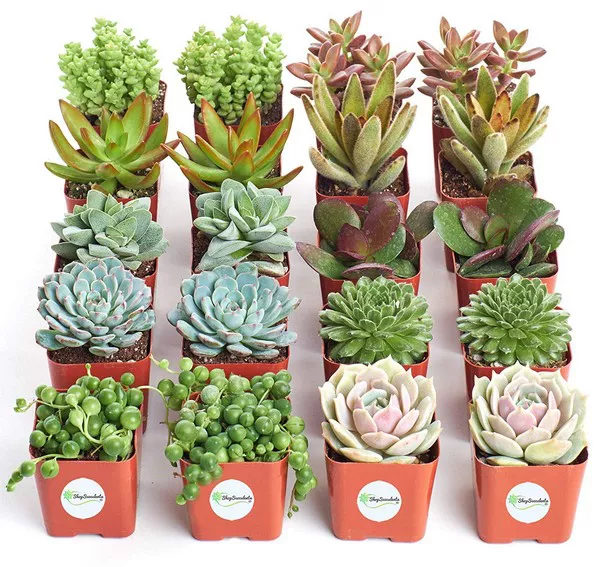Succulents have become popular household plants due to their unique beauty and low-maintenance requirements. These resilient plants store water in their fleshy leaves, allowing them to thrive in arid conditions.
Choosing the Right Succulent
The first step in succulent care is selecting the right plant. There is a wide variety of succulent species, each with unique characteristics and care requirements. It’s essential to choose succulents that match your environment and experience level. Some popular succulent types include Echeveria, Sedum, and Aloe Vera. Research the specific needs of your chosen succulent and ensure it suits your climate and indoor conditions.
Providing the Ideal Succulent Environment
To thrive, succulents need the right environment. Here are some key factors to consider:
a. Light: Succulents love bright, indirect sunlight. Place your succulents near a south- or west-facing window to ensure they receive sufficient light. Inadequate light can lead to leggy, stretched growth.
b. Temperature: Most succulents prefer a temperature range of 60-80°F (15-27°C). Protect them from extreme cold or heat, as this can stress the plants.
c. Soil: Use a well-draining succulent mix to prevent waterlogged soil. A typical mix includes potting soil and perlite or sand to ensure proper aeration and drainage.
d. Pot: Choose containers with drainage holes to allow excess water to escape. This prevents root rot, a common issue in succulent care.
Watering Succulents
One of the most critical aspects of succulent care is proper watering. Overwatering is a common mistake that can lead to root rot, while underwatering can cause your succulents to shrivel. Here’s a general guideline for watering succulents:
a. Water Sparingly: Allow the soil to dry out completely between watering. Stick your finger into the soil to about an inch deep; if it feels dry, it’s time to water.
b. Adjust for Season: Succulent watering needs change with the seasons. Water more frequently during the growing season (spring and summer) and reduce frequency in the dormant season (fall and winter).
c. Water the Soil, Not the Leaves: Avoid getting water on the leaves, as this can lead to rot and sunburn. Water the soil around the base of the plant.
d. Use the Soak and Dry Method: When you water, give your succulent a thorough soak and allow excess water to drain out. This ensures the roots get adequate moisture without sitting in standing water.
Fertilizing Succulents
Succulents do not require heavy fertilization, but they can benefit from occasional feeding. Use a balanced, liquid succulent fertilizer (e.g., 20-20-20) during the growing season, but use it sparingly. Typically, you should fertilize your succulents every 4-6 weeks.
Repotting Succulents
As succulents grow, they may outgrow their containers. It’s essential to repot them into larger pots to accommodate their growth. Here’s how to repot succulents:
a. Select a larger pot with drainage holes and prepare fresh succulent soil mix.
b. Carefully remove the succulent from its old pot, ensuring you don’t damage the roots.
c. Place the succulent in the new pot and fill in the gaps with fresh soil mix. Water lightly after repotting.
Pruning and Deadheading
Pruning and deadheading are essential aspects of succulent care. This helps maintain the plant’s shape, remove dead or damaged growth, and encourage healthy new growth. Use clean, sharp scissors or pruning shears to trim your succulent as needed.
Dealing with Succulent Pests
Succulents are generally resilient, but they can occasionally fall prey to pests like aphids, mealybugs, or spider mites. To protect your succulents, regularly inspect them for signs of infestation and address any issues promptly. Use insecticidal soap or neem oil to control pests without harming your plants.
Understanding Succulent Dormancy
Many succulents go through a dormant period, usually in the fall and winter. During this time, they require less water and might exhibit slower growth. Be sure to adjust your watering and care routine to accommodate their dormancy needs.
Propagating Succulents
Propagating succulents is a fun way to expand your collection. There are several methods, including leaf and stem cuttings, offsets, and seeds. Each method has its specific requirements, so be sure to research and follow the appropriate propagation technique for your succulent type.
Succulent Arrangements
Succulent arrangements are a beautiful way to display these unique plants. You can create stunning succulent gardens, centerpieces, and terrariums. When arranging succulents, consider their individual care needs, as some may require more space or light than others.
Succulent Care Myths
There are many myths and misconceptions about succulent care. One of the most common is that succulents thrive on neglect. While they are hardy plants, they still require appropriate care, including proper watering and light exposure. Avoid overgeneralizations and ensure you understand the specific care needs of your succulents.
Conclusion
Caring for succulents is a rewarding and enjoyable hobby that allows you to bring a touch of nature into your home or garden. Remember that succulent care is about balance, knowing your plants, and adapting your care routine to their specific needs. With the right care and attention, your succulents will reward you with their unique beauty and resilience.


